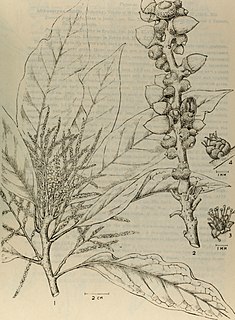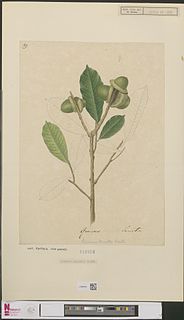Glycosmis longisepala is a tree of Borneo in the family Rutaceae. The specific epithet longisepala is from the Latin meaning "long sepal".
Castanopsis costata is a tree in the family Fagaceae. The specific epithet costata is from the Latin meaning "ribbed", referring to the leaf venation.
Castanopsis javanica, the Javan chestnut-oak, is a tree in the beech family Fagaceae. The specific epithet javanica is from the Latin, meaning "of Java".
Lithocarpus bancanus is a tree in the beech family Fagaceae. The specific epithet bancanus is from the Latin, meaning "of Bangka".
Lithocarpus bennettii is a tree in the beech family Fagaceae. It is named for the English botanist John Joseph Bennett.
Lithocarpus clementianus is a tree in the beech family Fagaceae. It is named for Governor Cecil Clementi Smith of the Straits Settlements.
Lithocarpus conocarpus is a tree in the beech family Fagaceae. The specific epithet conocarpus is from the Greek meaning "cone fruit", referring to the acorn shape.
Lithocarpus coopertus is a tree in the beech family Fagaceae. The specific epithet coopertus is from the Latin meaning "covered over", referring to the acorn.
Lithocarpus daphnoideus is a tree in the beech family Fagaceae. The specific epithet daphnoideus is from the Greek meaning "like Daphne", referring to the genus Daphne and its leaves.
Lithocarpus dasystachyus is a tree in the beech family Fagaceae. The specific epithet dasystachyus is from the Greek meaning "thickly hairy spike", referring to the inflorescence.

Lithocarpus elegans is a tree in the beech family Fagaceae. The specific epithet elegans is from the Latin meaning "elegant", referring to the acorns and cupules.
Lithocarpus hystrix is a tree in the beech family Fagaceae. The specific epithet hystrix is from the Greek meaning "spiny", referring to the cupule.

Lithocarpus lucidus is a tree in the beech family Fagaceae. The specific epithet lucidus is from the Latin meaning "shining", referring to the acorn and leaf surface.
Hopea andersonii is a tree in the family Dipterocarpaceae, native to Borneo. It is named for J. A. R. Anderson, a forest officer on the island.
Hopea bracteata is a tree in the family Dipterocarpaceae. The specific epithet bracteata means "thin metal plate", referring to the bracts of the inflorescence.
Hopea bullatifolia is a tree in the family Dipterocarpaceae, native to Borneo. The specific epithet bullatifolia means "blistered leaf".
Hopea cernua is a tree in the family Dipterocarpaceae. The specific epithet cernua means "slightly drooping", referring to the flowers.
Hopea dryobalanoides is a tree in the family Dipterocarpaceae. The specific epithet dryobalanoides means "resembling Dryobalanops", referring to that genus of trees and particularly their leaf veins.
Hopea obscurinerva is a tree in the family Dipterocarpaceae, native to Borneo. The specific epithet obscurinerva means "indistinct nerve", referring to the veins on the underside of the leaf.
Hopea rudiformis is a tree in the family Dipterocarpaceae, native to Borneo. The specific epithet rudiformis means "sword-shaped", referring to the leaf.

